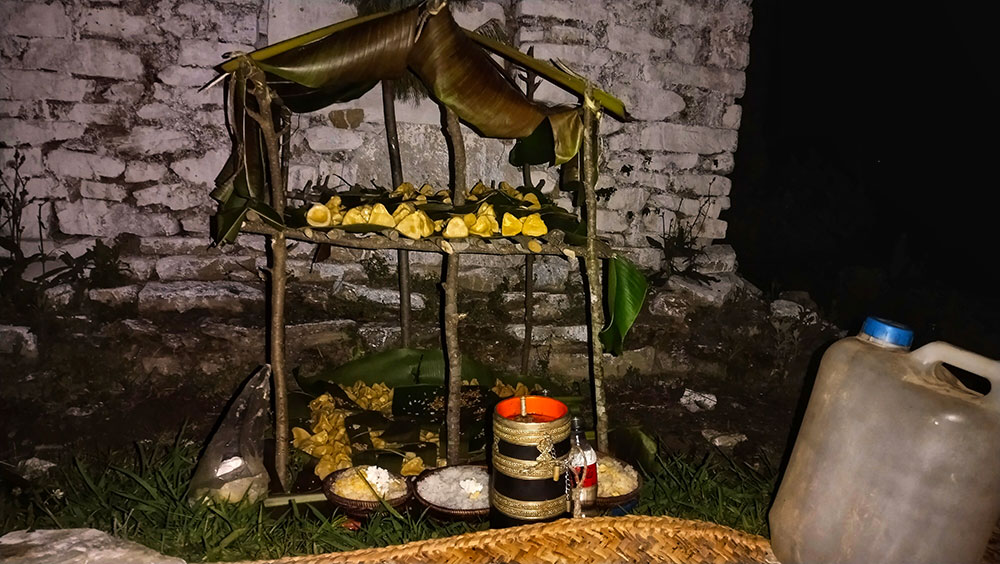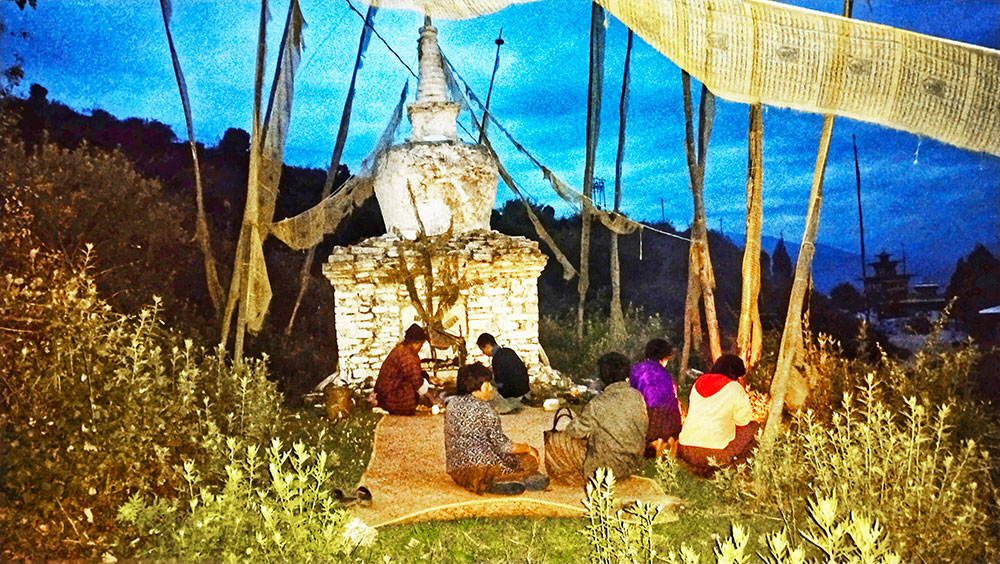Neten Dorji | Kanglung
Chaskhar, Mongar – The serene village of Chaskhar was abuzz with preparations for the Dhue Sanyen festival, a tradition that has shaped the beliefs of the community for generations.
The three-day festival, dedicated to safeguarding crops from natural calamities, has been a cornerstone of village life for as long as memory serves.
The meticulous preparations for Dhue Sanyen commence on the early morning of the 8th day of the 4th Bhutanese month, and Bonpo Dorji Tashi has long been an instrumental figure in organising the festivities.
The ritual-filled days centre around offerings and prayers for the land and its bountiful crops. As the sun rises, a small unit made from banana leaves is carefully arranged in front of the revered choeten, serving as a sacred vessel for ritual cakes. The ritual commences with a sang rite and libation offering, performed even before the arrival of Bonpo Dorji Tashi. With the choeten as their focal point, Bonpo and his devotees arrange tokari, the symbolic ritual cake, and tshogs.
Through these offerings and invocations, Bonpo Dorji Tashi seeks to imbibe mystical power to control weeds, birds, and insects that pose a threat to the crops. Moreover, his entreaties extend to the well-being of the villagers themselves.
In a solemn procession led by the Bonpo, villagers prostrate three times towards the choeten, signifying reverence. Following this, the Bonpo and his assistants distribute tshog to the assembled community members. The villagers partake in handfuls of tshog, accompanied by drops of banchang, a locally-brewed beer. The final act entails savouring the tokari, culminating in a shared communion with the divine.
During the festival, the Bonpo assumes authority over various activities within the village, issuing prohibitions on actions that may offend the deities. Cutting green plants, tilling wet soil, consuming meat, and engaging in conflicts are explicitly discouraged, fostering a sense of harmony among the villagers.

Bonpo offering tshog and Tokari infront of Choeten
These rituals underscore the locals’ steadfast belief in the worship of local deities, which reinforces the symbiotic existence of humans and nature.
On the concluding day of the festival, villagers celebrate with great fervour, adhering to the prohibition against plucking green plants and trees. Dorji Tashi says: “This day signifies the dominion of the community over any creature that jeopardises our crops. It represents the supernatural protection of our harvest from pests and weeds.”
As part of the festival preparations, Dorji Tashi collects grains from every household and brews the local elixir.
Tshering Dolma, an 83-year-old villager, emphasises that Dhue Sanyen is an inseparable part of their communal life. She says: “We firmly believe that our crops will remain unharmed after performing these rituals. For generations, we have sought aid from the natural forces to safeguard our meager livelihoods.”
During the festival, the villagers refrain from plucking green leaves, tilling wet soil, or engaging in agricultural work, as a mark of reverence and respect.
However, in recent years, Bon practices have experienced significant transformations, resulting in a decline in their significance and waning enthusiasm for participation. Traditional rituals and worship of local deities are being discouraged, as modern farming practices gain popularity. While lower parts of the village still offer grains, the upper villages have shifted towards offering butter and cheese.
Bonpo Dorji Tashi explains that the system of worship and offerings has undergone modifications due to changing times. “In the past, people used to offer three containers of grains, representing people, animals, and the land,” he reminisces. “Today, wheat and grains are scarcely offered, unlike before.”
In earlier times, fishermen would embark on expeditions to catch fresh fish from the Sherichu river to include as sacrificial elements. However, such practices have been abandoned due to concerns about the sinful nature of fishing and the festival coinciding with an auspicious month.
Regrettably, the next generation seems not interested in upholding the community’s sacred traditions. Bonpo Dorji Tashi laments: “My only worry is that once I retire, there will be no one to shoulder these responsibilities. I wish to pass down my knowledge to the youth, but there is currently no successor in sight.”
As the winds of change sweep across Chaskhar, it remains to be seen how this revered festival will navigate the evolving tides of time. For now, Dorji Tashi and his daughter tirelessly prepare for Dhue Sanyen, hoping to preserve the essence of an age-old celebration that has long defined their community.


